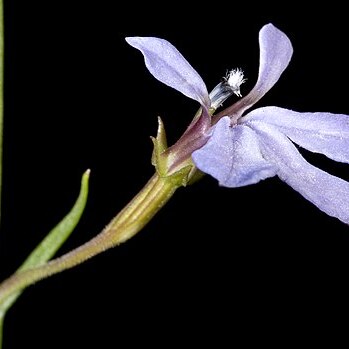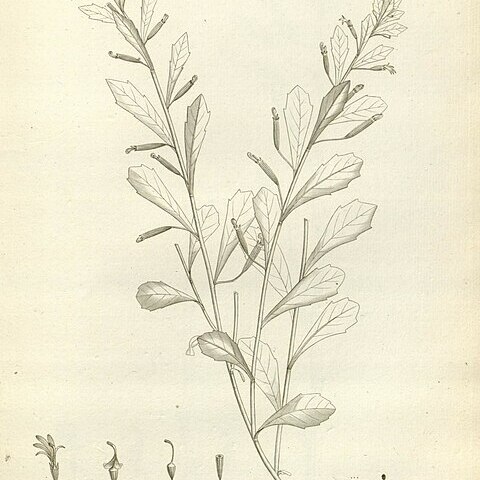Glab. herb with erect to spreading stems and branches, up to ± 4 dm. tall, us. less; branchlets grooved and angled, ± narrowly winged. Lvs of rather diverse form, on flat petioles up to ± 10 mm. long. Lamina entire to obscurely to distinctly toothed, fleshy to submembr.; of lower lvs broad-to oblong-ovate, narrowed into winged decurrent petiole, (10)-20-40-(50) × (5)-8-15 mm.; of mid lvs subsessile, narrow-oblong to lanceolate, ± 20-50 × 5-10 mm.; of upper and subfloral lvs sessile, lanceolate to linear, 10-30 × 1-5 mm. On many plants the lf-shape is more constant. Fls ± 5-10 mm. long, on very slender peduncles up to ± 10 mm. long, occ. confined to uppermost part of branchlets. Receptacle cylindric, grooved. Calyx-lobes short, triangular to linear, acute to acuminate. Corolla white to pale blue, 6-7 mm. long; lobes linear to oblong, acute. Capsule ± 8-12 mm. long, narrow-clavate.
A small herb. It grows each year from seed. It has slender winged stems. It grows 30 cm high. The leaves are alternate , simple and well spaced. The upper leaves are long and narrow. The leaves near the base are 3 cm long. The leaves have small teeth. The flowers are small and pale blue. They are along stalks that can be at the end of the stems or in the axils of leaves. The fruit are dry narrow capsules.
Stamens 4–11 mm. long, attached to the corolla at the base; filaments linear, connate for most of their length, sparsely pubescent mainly at the base; anther–tube 1–2·4 mm. long, the two lower anthers with a short hyaline appendage and a tuft of hairs at the apex, the three upper anthers usually with a tuft of hairs on the back near the apex.
Corolla 6–15(18) mm. long, blue or violet, split to ± 0·5 mm. from the base on the back, short pubescent on the inside of the tube near the base, glabrous or sparsely and minutely hairy on the outside; upper lobes linear, not broadened at the base.
Leaves somewhat fleshy, usually glabrous; lower ones linear–oblong to spathulate, often petiolate and ± obtuse at the apex, up to 80 x 21 mm., sparsely dentate–serrate or denticulate; upper ones narrower, sessile, often acute.
Racemes often lax; pedicels 2–8(10) mm. long, puberulous, shorter or longer than the bracts; bracteoles ± 1 mm. long, at base of pedicel.
Perennial decumbent to erect herb up to 60 cm. tall; stems usually glabrous, winged, often rooting at lower nodes.
Capsule cylindrical–obconical, up to 12 mm. long, puberulous or glabrous, 10–nerved; valves ± 1·5 mm. long.
Seeds broadly elliptic to subcircular in outline, somewhat compressed, ± 0·4 mm. long, finely striate.
Calyx–lobes narrowly triangular, erect, 1–3 mm. long, glabrous or puberulous.
Hypanthium narrowly obconical, c. 10–nerved, puberulous or glabrous.


